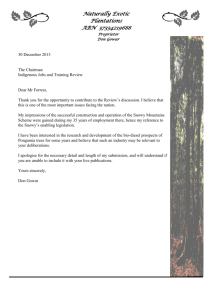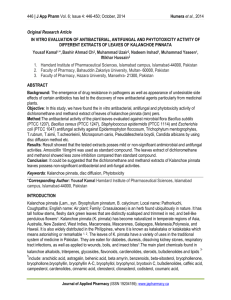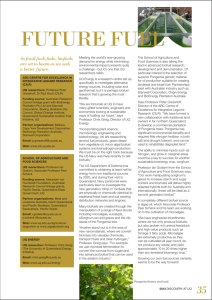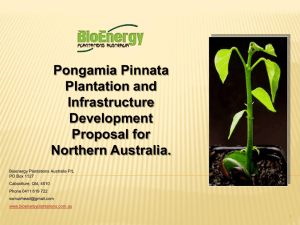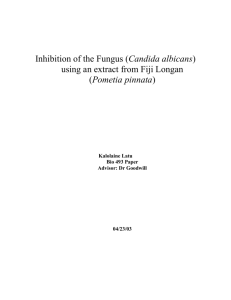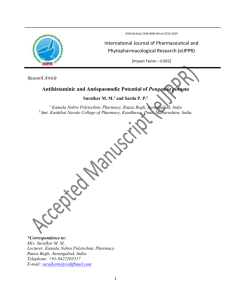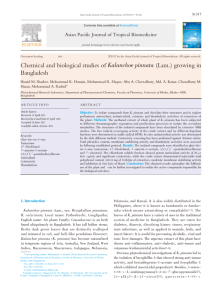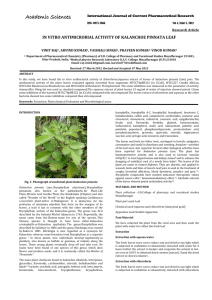Document 13308619
advertisement
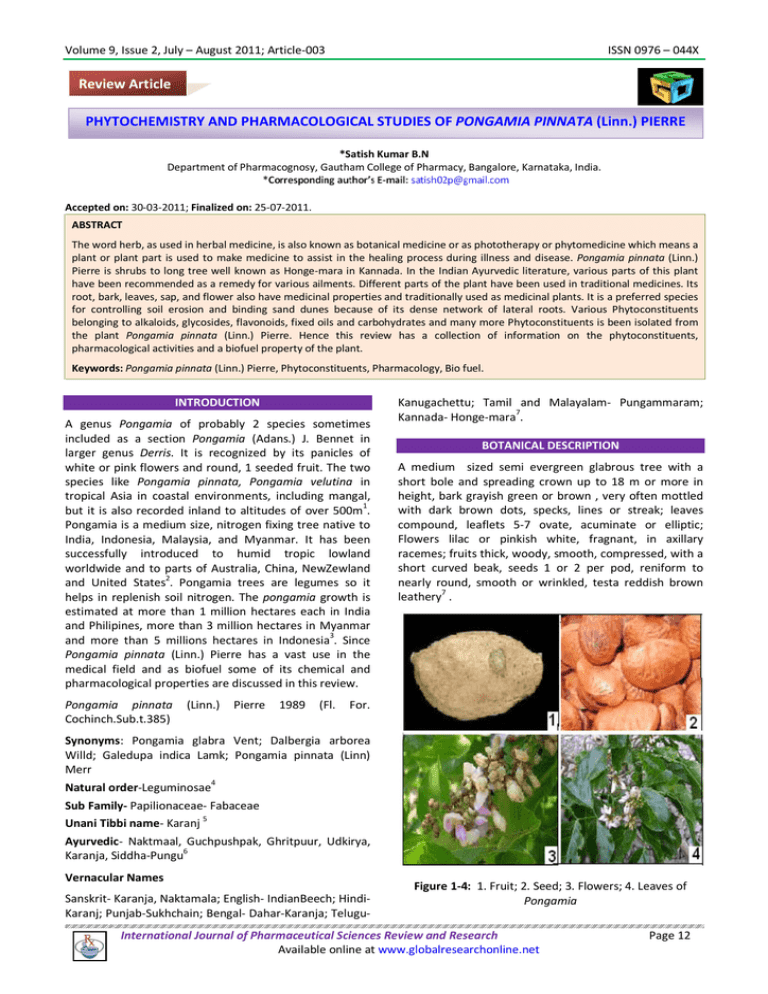
Volume 9, Issue 2, July – August 2011; Article-003 ISSN 0976 – 044X Review Article PHYTOCHEMISTRY AND PHARMACOLOGICAL STUDIES OF PONGAMIA PINNATA (Linn.) PIERRE *Satish Kumar B.N Department of Pharmacognosy, Gautham College of Pharmacy, Bangalore, Karnataka, India. Accepted on: 30-03-2011; Finalized on: 25-07-2011. ABSTRACT The word herb, as used in herbal medicine, is also known as botanical medicine or as phototherapy or phytomedicine which means a plant or plant part is used to make medicine to assist in the healing process during illness and disease. Pongamia pinnata (Linn.) Pierre is shrubs to long tree well known as Honge-mara in Kannada. In the Indian Ayurvedic literature, various parts of this plant have been recommended as a remedy for various ailments. Different parts of the plant have been used in traditional medicines. Its root, bark, leaves, sap, and flower also have medicinal properties and traditionally used as medicinal plants. It is a preferred species for controlling soil erosion and binding sand dunes because of its dense network of lateral roots. Various Phytoconstituents belonging to alkaloids, glycosides, flavonoids, fixed oils and carbohydrates and many more Phytoconstituents is been isolated from the plant Pongamia pinnata (Linn.) Pierre. Hence this review has a collection of information on the phytoconstituents, pharmacological activities and a biofuel property of the plant. Keywords: Pongamia pinnata (Linn.) Pierre, Phytoconstituents, Pharmacology, Bio fuel. INTRODUCTION A genus Pongamia of probably 2 species sometimes included as a section Pongamia (Adans.) J. Bennet in larger genus Derris. It is recognized by its panicles of white or pink flowers and round, 1 seeded fruit. The two species like Pongamia pinnata, Pongamia velutina in tropical Asia in coastal environments, including mangal, but it is also recorded inland to altitudes of over 500m1. Pongamia is a medium size, nitrogen fixing tree native to India, Indonesia, Malaysia, and Myanmar. It has been successfully introduced to humid tropic lowland worldwide and to parts of Australia, China, NewZewland and United States2. Pongamia trees are legumes so it helps in replenish soil nitrogen. The pongamia growth is estimated at more than 1 million hectares each in India and Philipines, more than 3 million hectares in Myanmar and more than 5 millions hectares in Indonesia3. Since Pongamia pinnata (Linn.) Pierre has a vast use in the medical field and as biofuel some of its chemical and pharmacological properties are discussed in this review. Pongamia pinnata Cochinch.Sub.t.385) (Linn.) Pierre 1989 (Fl. Kanugachettu; Tamil and Malayalam- Pungammaram; Kannada- Honge-mara7. BOTANICAL DESCRIPTION A medium sized semi evergreen glabrous tree with a short bole and spreading crown up to 18 m or more in height, bark grayish green or brown , very often mottled with dark brown dots, specks, lines or streak; leaves compound, leaflets 5-7 ovate, acuminate or elliptic; Flowers lilac or pinkish white, fragnant, in axillary racemes; fruits thick, woody, smooth, compressed, with a short curved beak, seeds 1 or 2 per pod, reniform to nearly round, smooth or wrinkled, testa reddish brown leathery7 . For. Synonyms: Pongamia glabra Vent; Dalbergia arborea Willd; Galedupa indica Lamk; Pongamia pinnata (Linn) Merr Natural order-Leguminosae4 Sub Family- Papilionaceae- Fabaceae 5 Unani Tibbi name- Karanj Ayurvedic- Naktmaal, Guchpushpak, Ghritpuur, Udkirya, Karanja, Siddha-Pungu6 Vernacular Names Sanskrit- Karanja, Naktamala; English- IndianBeech; HindiKaranj; Punjab-Sukhchain; Bengal- Dahar-Karanja; Telugu- Figure 1-4: 1. Fruit; 2. Seed; 3. Flowers; 4. Leaves of Pongamia International Journal of Pharmaceutical Sciences Review and Research Available online at www.globalresearchonline.net Page 12 Volume 9, Issue 2, July – August 2011; Article-003 Habitat: This tree is common all over India, and met from central Himalaya to southern India and Ceylon. It is of six varieties: In Bengal- Dahar Karanja; Makara Karanja; Bish Karanja and Amba Karanja. Karanja is one of the varieties 8 called Kanta- Karanja . Karanj is found in hilly region in south India up to an elevation of about 1220 mt and in Himalayas up to about 610 mts. It is found chiefly along streams and rivers and is common in the tidal and beach and dune forests along the sea shore9. Medical Action Rasa- Bitter, astringent and pungent; Guna- Light (The fruits and leaves). Light, sharp and Unctous (the oil); 4 Virya-Hot; Vipaka- Pungent . Flowering and fruiting: The tree flowers from about April to july and the pods ripen from about February to May in the following years. The exact period of flowering and fruiting of course, differs from locality to locality. SoilDeep sandy loams with abundant moisture. TemperatureMax:- 380 to 490; Min:- -10 to 160 Rainfall- Annual rainfall from 510 to 2540 mm. are the ideal conditions for the cultivation of the plant4. BOTANICAL CLASSIFICATION10 kingdom Plantae Division magnoliophyta Class magnolipsida Order fabales Family leguminoseae Genus Pongamia Species pinnata TRADITIONAL USES Seed oil-Applied to skin disease, in scabies, sores, herpes and the like cases of eczema have been benefited by applying a mixture of the oil and zinc oxide. Internally the oil has sometimes been used as stomachic and cholagogue in case of sluggish liver. Oil is styptic, anthelmintic, and good in leprosy, piles, ulcers, chronic fever and in liver pain7. Useful in rheumatism arthritis scabies11, whooping cough12. Leaves- Decoction of leaves is applied as bath or fomentation to rheumatic joints. Leaves are also used in diarrhea and in cough. Juice of leaves in treatment of flatulency, dyspepsia and diarrhea. Young leaves are applied to bleeding piles. Juice of leaves is used for cold, cough, diarrhea, dyspepsia, flatulence, gonorrhea, leprosy13-15. Stem- Juice of stem in remedy for Gonorrhoea. Aqueous extracts of stem bark exhibit significant CNS sedative and antipyretic activity16. Root- Juice in treatment of Gonorrhea, urethritis, good for cleaning foul ulcer, cleaning teeth, strengthening gums and gonorrhea. Juice of roots with coconut milk and 17-18 lime water used for treatment of gonorrhea . Roots ISSN 0976 – 044X are bitter anti-helmintic and used in vaginal and skin diseases19. Juice of the root is used for cleansing foul ulcers and closing fistulous sores20. Seed-Pulp of seed is an application in leprosy. Commonly used in Bronchitis and whooping cough. Used for keloid tumors. Used in hypertension, skin ailments and rheumatic arthritis21-23. Seed powder valued as a febrifuge, tonic and in bronchitis and whooping cough 12. Useful in inflammations, pectoral diseases, chronic fevers, 7 hemorrhoids and anemia . Bark-Useful internally in bleeding piles. It is anthelmintic and alexeteric and useful in hemorrhoids, beriberi, opthalmopathy, dermatopathy, vaginopathy and ulcer. For bleeding piles, for beriberi, reduce swelling of the spleen24. Useful in mental disorder, cough and cold18. Flowers- Dried flowers in powder in combination with other ingredients is given as decoction in diabetes to 7-8 17 quench thirst . Useful to quench dysepsia in diabetes , 25 for bleeding piles . Fruits-Fruits used for abdominal tumors26. Useful in ailments of female genital tract, leprosy, tumors, piles, ulcers and upward moving of the wind in the abdomen27. Seeds, leaves, roots and oil are Antiparasitic28. PHYTOCONSTITUENTS Seeds- Reported to contain alkaloids demethoxy-kanugin, gamatay, glabrin, glabrosaponin, kaempferol, kankone, kanugin, karangin, neoglabrin, pinnatin, pongamol, pongapin, quercitin, saponin, β-sitosterol and tannin. Seeds have 19.0% moisture, 27.5% fatty oil, 17.4% protein, 6.6% starch, 7.3% crude fibre and 2.4% ash29-30. The proximate composition of P. pinnata seeds was: 3.8% ash, 9.7% sugar, 7.07% protein, 24% oil, 10.7% free amino acids, and 0.24% free fatty acids. The oil was extracted from seeds by use of different solvents and the highest yield (29%) was obtained by use of n-hexane31. Seeds in addition gave lanceolatin B, iso-pongachromene and pon gaglabrone7. Bark- contains a bitter alkaloid, resin, mucilage, sugar, but no tannin. From the stem bark of Pongamia pinnata, two new compounds, 3-methoxy-(3,4-dihydro- 3-hydroxy-4acetoxy)-2,2-dimethylpyrano-(7,8:5,6)-flavone and 3methoxy-(3,4-dihydro-4hydroxy-3-acetoxy)-2,2dimethylpyrano-(7,8:5,6)-flavone, were isolated, along with six known compounds, caryophyllene oxide, obovatachalcone, 8-hydroxy-6-methoxy-3-pentyl-1Hisochromen-1-one,6,7,2,2-dimethylchromono-8,dimethylallylflavanone, isolonchocarpin, ovaliflavanone A. Their structures were determined on the basis of the spectroscopic data interpretation32. Leaves- also contain a bitter substance. The qualitative phytochemical study reveals the presence of alkaloids, carbohydrates, phytosterols, saponins, tannins and 33 flavonoids in leaves . Chromatographic separation of a 70% aqueous methanol extract (AME) of leaves has led to International Journal of Pharmaceutical Sciences Review and Research Available online at www.globalresearchonline.net Page 13 Volume 9, Issue 2, July – August 2011; Article-003 the isolation of two new isoflavonoid diglycosides, 4'-Omethyl-genistein 7-O-beta-D-rutinoside and 2',5'dimethoxy-genistein 7-O-beta-D-apiofuranosyl-(1"'6")-Obeta-D-glucopyranoside, and a new retinoid, 12ahydroxy-alpha-toxicarol, together with nine known metabolites, vecinin-2, kaempferol 3-O-beta-D-rutinoside, rutin, vitexin, isoquercitrin, kaempferol 3-O-beta-Dglucopyranoside, 11,12a-dihydroxy-munduserone, kaempferol, and quercetin34. Manurial values of leaves and twigs are respectively: nitrogen 1.16, 0.71; phosphorus 0.14, 0.11; potash 0.49, 0.62; and lime (CaO), 1.54, 1.58%29-30. The decoction of leaves showed presence of carbohydrates, proteins, saponins, tannins and flavonoids35-40. Seed oil- contains Karanjin (S18H12O4); Fatty acid present in oil include myristic 0.23, palmitic 6.06, stearic 2.19, arachidic acid 4.30, Lignoceric acid 3.22, Dihydro stearic 4.36, Lino lenic acid 0.46, Lenolic acid 9.72, oleic acid 61.30 percent, together with 3.56% of unsaponifiable matter7-8. Phytochemical evaluation of Pongamia pinnata seed oil resulted in the isolation of methyl oleate and 3'methoxy (2",3":7,8) furanoflavone. These compounds were characterized on the basis of spectral and other data. seed oil gave Karanjin, pongamol, pongapin and Kanjone. Glabrachalcone was isolated from the seed oil6. ISSN 0976 – 044X Figure 7: Structures of phytoconstituents isolated from the flower of Pongamia pinnata Aurantiamide acetate Figure 8: Structures of phytoconstituents isolated from the fruits of Pongamia pinnata Furanoflavonoids, pongapinnol A–D (1–4), and a new coumestan, pongacoumestan (5). Figure 9: Structures of phytoconstituents isolated from stem bark of Pongamia pinnata Flowers- yield simple flavones, hydroxyl furanoflavones, chemnoflavanone, triterpenes, beta sitosterol glucoside and aurantiamide acetate. Roots- Some of the anticancer compounds like Paclitaxel, Flurophenylalaline, Vinblastin, Vincristine (Sulphate), Teniposide, Fluoxetine, Oetoposide derivatives are present in the root extract of Pongamia pinnata41. Figure 5: Structures of Phytoconstituents isolated from the seeds of Pongamia pinnata. Pongaflavanol tunicatachalcone PHARMACOLOGICAL ACTIVITIES Anti-Plasmodia activity The ethanolic extracts of Pongamia pinnata were examined in vitro for antiplasmodial properties against Plasmodium falciparum. This ethanol extract of Pongamia pinnata shows significant anti-plasmodial activity42. Anti-Inflammatory activity Figure 6: Structures of Phytoconstituents isolated from the roots of Pongamia pinnata. Vinblastin Paclitaxel The ethanolic extract of Pongamia pinnata seed had exhibited an anti-inflammatory effect in chemically induced anti inflammatory rat. Different solvent fractionated extracts were evaluated for antiinflammatory effect. Anti-inflammatory effects of Pongamia pinnata were best seen against bradykinin and PGE1-induced inflammation. In contrast minimal effects were seen against histamine and 5-HT-induced inflammation. The predominant action of extracts of Pongamia pinnata appears to be a modulation of eicosanoid-events in inflammation43. The anti-inflammatory activity of aqueous extract of Pongamia pinnata stem bark (PPSB) in acute and chronic models of inflammation was evaluated in albino rats. Oral administration of PPSB (400, 800 mg/kg) exhibited significant anti-inflammatory activity in acute International Journal of Pharmaceutical Sciences Review and Research Available online at www.globalresearchonline.net Page 14 Volume 9, Issue 2, July – August 2011; Article-003 (carrageenin induced hind paw edema) and chronic (cotton pellet granuloma) models of inflammation. The PPSB hold significant anti-inflammatory activity without 44 ulcerogenic activity . This anti-inflammatory and analgesic potential of the methanolic extract of pongamia pinnata stem bark (PSBE) in was evaluated. PSBE (200, 500 and 1000 mg/kg) exhibited significant anti-inflammatory activity in acute (carrageenan induced hind paw edema) and chronic (cotton pellet granuloma) models of inflammation PSBE. The analgesic activity was tested by acetic acid-induced writhing response in albino mice and tail flick method in albino rats. Its methanolic extract shows the most effective anti-inflammatory activity at doses of 200, 500 and 1000 mg/kg significantly throughout the observation period. In the tail flick model, the PSBE showed dosedependent action in all experimental animal models45. In the present study, the anti-inflammatory activity of 70% ethanolic extract of Pongamia pinnata leaves (PLE) in acute, subacute and chronic models of inflammation was assessed in rats. p.o. administration of PLE (300, 1000 mg/kg) exhibited significant anti-inflammatory activity in acute (carrageenin, histamine, 5-hydroxytryptamine and prostaglandin E2-induced hind paw edema), subcute (kaolin-carrageenin and formaldehyde-induced hind paw edema) and chronic (cotton pellet granuloma) models of inflammation. This indicates that PLE possesses significant anti-inflammatory activity without ulcerogenic activity46. Anti-diarrhoeal Activity The crude decoction of dried leaves of Pongamia pinnata was evaluated for anti-microbial effect and also its action on enterotoxins (cholera toxin, Escherichia coli labile toxin and E. coli, stable toxin) and adherence of enteropathogenic E. coli and invasion of enteroinvasive E. coli and Shigella flexneri to epithelial cells. The decoction had no anti-bacterial, anti-giardial, and anti-rotaviral activities, but reduced production of cholera toxin and bacterial invasion to epithelial cells. Thus it suggest that it is not active against toxin induced diarrhea or those caused by protozoa and virus. Amongst bacterial diarrhea, it appears to be most efficacious against cholera and enteroinvasive bacterial strains causing bloody diarrheal episodes. These results support their traditional use as an antidiarrheal therapy47. Anti bacterial Activity The antibacterial activity of Karanj (Pongamia pinnata) and Neem (Azadirachta indica) seed oil in vitro against fourteen strains of pathogenic bacteria was assessed by using the tube dilution technique at concentration of 125 microl/ml, 250 microl/ml and 500 microl/ml. The activity with both the oils was bactericidal and independent of temperature and energy. The activity was mainly due to the inhibition of cell-membrane synthesis in the bacteria. Seed oil showed inhibition against the tested fungal and bacterial cultures. The efficacy of antimicrobial activity of the seed oil at four concentration levels (50%, 80%, 90% ISSN 0976 – 044X and 100%) against various pathogenic indicators was found to be concentration-dependent48. The various organic extracts of chloroform, ethyl acetate and methanol, derived from the leaves of Pongamia pinnata (L.) Pierre was evaluated for antibacterial potential against some representative food spoilage and food-borne pathogenic bacteria like Bacillus subtilis ATCC6633, Staphylococcus aureus ATCC6538, Listeria monocytogenes ATCC19118, L. monocytogenes ATCC19166, Pseudomonas aeruginosa ATCC6432 and Salmonella typhimurium ATCC2512. The organic extracts of chloroform, ethyl acetate and methanol, at a concentration of 2500 µg/mL. The chloroform, ethyl acetate and methanol extracts displayed significantly higher antibacterial activity as compared to streptomycin. This study suggests that P. pinnata may have potential antimicrobial agent49. Antioxidant and Anti-hyperammonemic Activity The effect of Pongamia pinnata leaf extract (PPEt) on circulatory lipid peroxidation and antioxidant status was evaluated in ammonium chloride-induced hyperammonemic rats. Enhanced lipid peroxidation in the circulation of ammonium chloride-treated rats was accompanied by a significant decrease in the levels of vitamin A, vitamin C, vitamin E, reduced glutathione (GSH), glutathione peroxidase (GPx), superoxide dismutase (SOD), and catalase (CAT). PPEt-administered rats experienced a significant reduction in lipid peroxidation with a simultaneous elevation in antioxidant levels. The results indicate that PPEt modulates these changes by reversing the oxidant–antioxidant imbalance during ammonium chloride-induced hyperammonemia and this could be due to its antihyperammonemic effect by means of detoxifying excess ammonia, urea and creatinine and antioxidant property50. Hepatoprotective Activity Effect of Pongamia pinnata leaf extract (PPEt) were studied for it’s hepatoprotective effect during ammonium chloride induced hyperammonemia. Ammonium chloride treated rats showed significant increase in the level of circulatory ammonia, urea, bilirubin, AST, ALT, ALP, LDH, GGT, TBARS and HP. These levels were decreased in PPEt treated animals. The result indicates that PPEt offers hepatoprotection by influencing the level of lipid peroxidation products and liver markers in experimental hyperammonemia and this could be due to its ability to detoxify excess ammonia, urea and creatinine and free radical scavenging property by means of reducing lipid peroxidation and the presence of natural antioxidants51. Anti-ulcer Activity The present work includes study of ulcer protective and healing effect of methanol extract of seed of Pongamia pinnata (PPSM) in rats. PPSM showed ulcer protection effect against gastric ulcer induced by cold stress, pylorous ligation, aspirin and duodenal ulcer induced by cysteamine but not protective action against ethanol International Journal of Pharmaceutical Sciences Review and Research Available online at www.globalresearchonline.net Page 15 Volume 9, Issue 2, July – August 2011; Article-003 induced gastric ulcer. It also cured chronic gastric ulcer induced by acetic acid. PPSM tended to decrease the acid output and increased mucin secretion and mucosal cell shedding, glycoproteins, proliferation and anti oxidants; catalase (CAT), superoxide dismutase (SOD) and glutathione (GSH) levels. Thus it shows significant anti ulcer activity52. Sequential petroleum ether, benzene, chloroform, acetone and ethanolic extracts of Pongamia pinnata roots is administered in the dose of 50 mg/kg i.p., they were also found to possess antiulcer effects when administered either by i.p. (45 min before) or oral route (45 min before or for 4 days) against restraint-stress or pylorus-ligated gastric ulcers in rats, the maximum protection being afforded by petroleum ether and ethanol extracts. The mechanism of antiulcer effect could either be due to decrease in acid-pepsin secretion and augmentation of mucin secretion as observed with ethanol extract, while petroleum ether extract might be producing the effect by virtue of its anti-stress activity53. The Present study was designed to investigate the antiulcer effect of hydroalcoholic extract of leaves of P. pinnata (HLEPP) in aspirin or ethanol or indomethacin or pylorus-ligated models of gastric ulceration in rats. HLEPP was administered in the dose of 400 mg/kg orally in all experiments. HLEPP at the dose of 400 mg/kg produced a significant reduction in the ulcer index. HLEPP significantly inhibited gastric mucosal damage induced by aspirin, ethanol, and indomethacin and in pylorus-ligated rats. The anti-ulcer effect was further confirmed histologically. The above effects of HLEPP may also be due to the presence of tannins and flavonoids in the extract33. The methanolic extract of Pongamia pinnata roots showed significant protection against aspirin, but not against ethanol-induced ulceration. It showed tendency to decrease acetic acid-induced ulcers54. Anticonvulsant activity The anticonvulsant effect of 70% ethanol extract of Pongamia pinnata leaf against pentylene tetrazole induced convulsion (PTZ) in rats was evaluated. The ethanolic extract showed significant anticonvulsant activity by lowering the duration of extension phase (3.72 ± 0.65) when compared to control group (8.94 ± 0.42). From the experiment Pongamia pinnata had shown significant anticonvulsant activity55. Investigation of the anticonvulsant efficacy of 70% ethanol leaf extract of Pongamia pinnata using maximal electroshock-induced seizure (MES) in mice showed significant anticonvulsant activity by lowering the duration of extension phase (4.12 ± 0.67) when compared to control group (9.64 ± 0.41). These significant results indicate that the anticonvulsant action of Pongamia pinnata leaf extract on mice, probably due to the presence of flavonoids56. ISSN 0976 – 044X Hypoglycemic and Hypolipidemic Activity The methanol extract of pod, flower of Pongamia pinnata (Linn.) Pierre of was evaluated for its hypoglycemic and hypolipidemic activity in streptozotocin induced diabetic rats. A new difuranoflavonone Compound PP (named Pongamiaflavonol), isolated from methanolic extract of P. pinnata pods was also studied for the activity. It was observed that after 14 days of treatment blood glucose level was reduced by 66.34, 54.82, 63.62 and 67.48 % -1 with Std. Glibenclamide 3 mg kg ), P. pinnata pods (300 -1 mg kg ), P. pinnata flowers (300 mg kg-1) and PP (100 mg kg-1), respectively. The lipid profile was also studied and was found to be normalized significantly by both the flowers and pods extracts of P. pinnata and compound PP57. Antihyperglycemic and Antilipidperoxidative Effect The antihyperglycemic and antilipid peroxidative effect of ethanolic extract of Pongamia pinnata (Linn.) Pierre flowers (PpEt) was evaluated in normal rats and in alloxan induced diabetic rats. The oral administration of ethanolic extract of Pongamia pinnata flowers (300 mg/kg bw) showed significant antihyperglycemic, and antilipidperoxidative effects and enhancement in antioxidants defense system in alloxan induced diabetic rats. However, no significant characteristic changes were noticed in blood glucose level as well as in lipid peroxidation and antioxidant status in normal rats treated with “PpEt” alone. Thus the “PpEt” could be used as a safe alternative antihyperglycemic drug for diabetic patients58. Antiviral Activity Pongamia pinnata, Linn. for treatment of clinical lesions of skin and genital, was evaluated for antiviral properties against herpes simplex virus type- 1 (HSV- 1) and type-2 (HSV-2) by in-vitro studies in Vero cells. A crude aqueous seed extract of P. pinnata completely inhibited the growth of HSV-1 and HSV-2 at concentrations of 1 and 20 mg/ml (w/v), respectively, as shown by complete absence of cytopathic effect59. Antidiabetic activity The antidiabetic activity of petroleum ether, chloroform, alcohol and aqueous extracts of P. pinnata leaf extracts was investigated in alloxan-induced diabetic albino rats. P. pinnata ethanolic extract (PPEE) and aqueous extract (PPAE) showed significant (P < 0.001) antidiabetic activity. The drug has the potential to act as an antidiabetic drug60. The antidiabetic activity of cycloart-23-ene-3beta, 25-diol isolated from stem bark of Pongamia pinnata was evaluated against streptozotocin-nicotinamide induced 61 diabetic mice. It showed significant antidiabetic activity . Renal protective activity Ethanolic extract of flowers of Pongamia pinnata was studied for its protective effect against cisplatin and gentamicin induced renal injury in rats. Toxicity of International Journal of Pharmaceutical Sciences Review and Research Available online at www.globalresearchonline.net Page 16 Volume 9, Issue 2, July – August 2011; Article-003 cisplatin, is measured by loss of body weight, elevated blood urea and serum creatinine declined significantly. Ethanolic extract of flowers had a marked nitric oxide free radical scavenging effect, suggesting an antioxidative property. Two flavonoids, known for their antioxidant activity viz. kaempferol and 3, 5, 6, 7, 8-pentamethoxy flavone were isolated from the extract. The flowers of Pongamia pinnata had a protective effect against cisplatin and gentamicin induced renal injury through antioxidant 62 property . ISSN 0976 – 044X Pongamia pinnata is a source of many market formulations due to its various proved Pharmacological actions and of enormous isolated Phytoconstituents. It is a reliable bio fuel and interest must be focused on further development of Pongamia pinnata as a potent biofuel and many more studies should be done in pharmacognostical part. REFERENCES 1. Tomlinson PB, The botany of mangroves, Cambridge University Press, New York, 1994, 260. 2. Daniel JN, Pongamia pinnata a nitrogen fixing tree for oil, 1997, In: NFT highlights NFTA 97-03. 3. Elizabeth Cushion, Adrian Whiteman, Gerhard Dieterle, Bioenergy development: issues and impacts for poverty and natural resource management, The World Bank, Washington,2010, pp. 199-202 4. Saligrama Krishna Ramachandra Rao, Encyclopaedia of Indian Medicine: Materia medica- Herbal drugs. Vol 4. Popular Prakashan, 2005: pp. 129. 5. Niir Board of Consultants and Engineers. Hand book of unani medicines with formulae, processes, uses and analysis. Asia pacific Business Press Inc. NewDelhi: pp. 201. 6. Khare CP. Indian medicinal plants: an illustrated dictionary. Springer science, Berlin, 2007, 209. 7. Warrier P K, Nambiar VPK, Ramankutty C. Indian medicinal plants: a compendium of 500 species, volume 4. Orient Longman private Limited, Hyderabad, 1995, 339344. 8. Singh MP, Himadri Panda. Medicinal Herbs with Their Formulations. Daya publishing House, Delhi, 2005, 678680. 9. Niir Board. Modern Technology of Oils, Fats & its Derivatives. Asia pacific Business Press Inc., NewDelhi, 142-146. Pongamia pinnata as Bio fuel Pongamia seed oil as a bio- fuel has physical properties very similar to conventional diesel. Emission properties, however, are cleaner for Bio- fuel than for conventional diesel. It has no polyaromatic compounds and reduced toxic smoke and soot emissions. A drastic reduction in sulphur content (<350ppm) and higher cetane number (>51) will be required in the petroleum diesel produced by Indian refineries. However, bio-fuel meets these two important specifications and would help in improving the lubricity of low sulphur (0.13-0.16%) diesel. The present specification of flash point for petroleum diesel is 350°C which is lower than all the countries in the world (>550C). Bio-fuel will help in raising the flash point, a requirement of safety63. Table 1: Comparison of biofuel with petroleum diesel Property Viscosity (cp) (30°C)52.6 Specific gravity (15°C/4°C Bio-fuel 5.51 Petroleum diesel 3.60 0.917 0.841 Solidfying Point (°C) Cetane Value Flash Point (°C) Carbon Residue (%) 2.0 51.0 110 0.64 0.14 47.8 80 0.05 Distillation (°C) Sulfur (%) Acid Value Saponification Value Iodine Value 284 to295 0.13 to 0.16 1.0 to38.2 188 to 198 90.8 to 112.5 350 1.0 Refractive Index (30°C) 1.47 The level of erucic acid and the presence of toxic flavonoids, for example karanjin, pongapin, and pongaglabrin, render the oil inedible according to WHO recommendations. However, low levels of saturated and polyunsaturated fatty acids with desirable cetane number and iodine value suggest potential for application as a biodiesel fuel31. CONCLUSION In recent years of scientific investigations, attention has been drawn to the health promoting activity of plant foods and its active components. Many herbal remedies have been recommended in various medical treatises for the cure of different diseases. This plant is a multipurpose tree with immense medicinal and economic value. The 10. http://www.ayushveda.com/herbs/pongamia-pinnata. 11. Prasad G, Reshmi MV. A manual of medicinal trees. Agrobios India 132 p.a Propagation Methods. Foundation for Revitalization for Local Health Tradition, India 2003. 12. CSIR. The Wealth of India: raw materials. Vol. 1-10. Council of Scientific and Industrial Research (CSIR), New Delhi, India, 1948-98. 13. Ambasta SP, Ramchandran K, Kashyapa K, Chand R. The Useful Plants of India. Council of Science and Industrial Research (CSIR), New Delhi. 1992. 14. Oommen S, Ved DK, Krishan R. Tropical Indian Medicinal Plants: Oregon. USA, 2000, 599. 15. Bhattacharjee SK. Handbook of Medicinal Plants.IIIrd edition, Pointer Publishers, Jaipur, India, 2001, 478. 16. Philip T, Sharma DD, In vitro evaluation of leaf and oil cake extracts of Azadirachta indica and Pongamia glabra on mulberry root rot pathogens, Indian Sericulture, 36, 1997, 150-152. International Journal of Pharmaceutical Sciences Review and Research Available online at www.globalresearchonline.net Page 17 Volume 9, Issue 2, July – August 2011; Article-003 17. Joshi SG Medicinal Plants. Oxford & IBH Publishing, New Delhi, 2006. 18. Manandhar NP, Plants and People of Nepal, Timber Press, Portland, Oregon, USA, 2002, 599. 19. Gills AS, Bisaria AK, Shukla SK, Potential of Agroforestry as Sources of Medicinal Plants. JN Govil (ed).Today and Tomorrow’s publishers, New Delhi, India, 1998. 20. Go N, Medicinal Plants of Nepal. Bulletin of the Department of Plant Resources NO.28. Ministry of Forest and Soil Conservation, Thapathali, Kathmandu, Nepal 2007,402. 21. Ballal M. Screening of medicinal plants used in rural folk medicine for treatment of diarrhea 2005. Internet: Http: // WWW.Pharmoinfo.net. 22. Tanaka T, Iinuma M, Fujii Y, Yuki K, Mizuno M, Flavonoids in root bark of Pongamia pinnata. Phytochemistry, 31,1992, 993-98. 23. Carcache Blanco EJ, Kang YH, Park EJ, Su BN, Kardono LBS, Riswan S, Fong HHS, Pezzuto JM, Kinghorn AD, Constituents of the stem bark of Pongamia pinnata with the potential to induce quinine reductase, J. Nat. Prods 66, 2003, 1197-1202. ISSN 0976 – 044X 35. Agbor GA, Leopold T, Jeanne NY, The antidiarrhoeal activity of Alchornea cordifolia leaf extract. Phytother Res, 18(11), 2004, 873–876. 36. Galvez J, Zarzuelo A, Crespo ME, Utrilla MP, Jimenez J, Spiessens C, de Witte P. Antidiarrhoeic activity of Scleroarya birrea bark extract and its active tannin constituent in rats. Phytother Res, 5, 1991, 276–278. 37. Lutterodt GD, Ismail A, Basheer RH, Baharuddin MH. Antimicrobial effects of Psidium guajava extract as one mechanism of its antidiarrhoeal action. Malaysian J Med Sci, 6(2), 1999, 17–20. 38. Miranda D, Pereira L, Sirsat SM, Antarkar DS, Vaidya AB, In vitro action of Dadima (Punica granatum Linn.) against microorganisms involved in human gastrointestinal infections—isolation and identification of tannins, Journal of Research in Ayurveda and Siddha, 14(3-4),1993,154– 164. 39. Mukherjee PK, Saha K, Murugesan T, Mandal SC, Pal M, Saha BP, Screening of anti-diarrhoeal profile of some plant extracts of a specific region of West Bengal, India. J Ethnopharmacol, 60(1), 1998, 85–89. 24. Kirtikar KR, Basu BD, Indian Medicinal Plants Vol.II., Bishen Singh Mahendra Pal Singh, Dehradun,1984, 830. 40. Oben JE, Assi SE, Agbor GA, Musoro DF. Effect of Eremomastax speciosa on experimental diarrhoea. African J Traditional Complimentary Alternative Med, 3(1), 2006, 95–100. 25. Baral SR, Kurmi PP, A Compendium of Medicinal Plants Nepal, Mrs Rachana Publishers, Kathmandu, Nepal, 2006, 534. 41. Sagar PK and Paliwal RK, Isolation and study of active material having medicinal value present in Pongamia pinnata( vent). 2003, 103-106. 26. Hartwell JL, Plants used against cancer, A survey, Lloydia, 1967-71,30-34. 42. Simonsen HT, Nordskjold JB, Smitt UW, In vitro screening of Indian medicinal plants for antiplasmodial activity, J Ethnopharmacol, 74,2001, 195-204. 27. Rastogi RP, Mehrotra BN, A Compendium of Medicinal Plants vol.1. Central Drug Research Institute, Lucknow and Publication and Information Directorata, New Delhi 196069, 497. 28. Narayanrao UB, Indigenous Medicinal Biotech Books, NewDelhi, 2001, 30. Specialities, 29. DukeJA,HandbookofEnergyCrops.(Unpublisheddata) http://WWW.hortpurdue.edu/duke_energy/pongamiapin nata.htm, 1983 30. Singh RV. Fodder trees of India .Oxford & IBH Co. New Delhi, India.1982. 31. Manju Bala, Nag TN, Sandeep Kumar, Manmohan Vyas, Arun Kumar and Bhogal NS. Proximate Composition and Fatty Acid Profile of Pongamia pinnata, a Potential Biodiesel Crop. J Am Oil Chem Soc, 53, 2010, 470–474. 32. Hao Yin, Si Zhang, Jun Wu, Haihan Nan, Dihydropyranoflavones from Pongamia pinnata. J. Braz. Chem. Soc, 17 (7), 2006, 1432-1435. 33. Mahendra, Giri, rasika. Bhalke and subodh .pal. Gastroprotective effect of hydroalcoholic leaves extract of pongamia pinnata. International journal of Pharma and Bio science, 1(3), 2010, 1-6. 34. Marzouk MS, Ibrahim MT, El-Gindi OR, Abou Bakr MS, Isoflavonoid glycosides and rotenoids from Pongamia pinnata leaves, Z Naturforsch C, 63(1-2),2008,1-7. 43. Singh RK, Pandey BL, Anti-inflammatory activity of seed extracts of Pongamia pinnata in rat , Indian J Physiol Pharmacol, 40(4),1996,355-8. 44. Nadagouda Smitha G, Karigar Asif A, Sikarwar Mukesh S, Geetanjali SS, Anti-inflammatory activity of Pongamia Pinnata stem bark in rats. J. Pharmacy Res, 3(4), 2010. 45. Manoj kumar sagar, Praveen kumar, Ashok k. Upadhyaya. Anti-inflammatory and analgesic activities of methanolic extract of pongamia pinnata stem bark. Int. J. pharma prof res, 1(1), 2010, 5-9. 46. Srinivasan K, Muruganandan S, Lal J, Evaluation of antiinflammatory activity of Pongamia pinnata leaves in rats. J Ethnopharmacol, 78, 2001, 151–157. 47. Brijesh S, Daswani PG, Tetali P, Studies on Pongamia pinnata (L.) Pierre leaves: Understanding the mechanism(s) of action in infectious diarrhea, J Zhejiang Univ. Sci. B 7, 2006, 665-74. 48. Vigya Kesari, Archana Das and Latha Rang, Physicochemical characterization and antimicrobial activity from seed oil of Pongamia pinnata, a potential biofuel crop, Biomass and Bioenergy, 34(1), 2010, 108-115. 49. Vivek K Bajpai, Atiqur Rahman, Savita Shukla, Archana Mehta, Shruti Shukla, Yassir Arafat SM, Mizanur Rahman M, Zennat Ferdousi. Antibacterial activity of leaf extracts of Pongamia pinnata from India, Pharm Biol, 47(12), 2009, 1162-1167. International Journal of Pharmaceutical Sciences Review and Research Available online at www.globalresearchonline.net Page 18 Volume 9, Issue 2, July – August 2011; Article-003 ISSN 0976 – 044X 50. Essa MM, Subramanian P, Pongamia pinnata modulates the oxidant-antioxidant imbalance in ammonium chlorideinduced hyperammonemic rats, Fundam Clin Pharmacol, 20, 2006, 299-303. 51. Mohamed Essa M, Subramanian P. Hepatoprotective Effect of Pongamia pinnata Leaves in Ammonium Chloride induced Hyperammonemic Rats. J. Pharmacol. Toxicol, 3(1), 2008, 20-26. 52. Prabha T, Dorababu M, Shalini Goel, Agarwal PK, singh A, Joshi VK, Goel KK, Effect of mrthanol extract of pongamia pinnata Linn seed on gastro-duodenal ulceration and mucosal offensive factors in rats. Indian J. Exp. Biol, 47, 2009, 649-659. 53. Singh RK, Nath G, Acharya SB, Goel RK, Pharmacological actions of Pongamia pinnata roots in albino rats. Indian J. Exp. Biol, 35,1997, 831-836. 54. Meera B, Kumar S, Kalidhar SB, A review of the chemistry and biological activity of Pongamia pinnata, J Med Aromat Plant Sci, 25,2003,441-65. 55. Ashish manigauha, sunita patel, Anticonvulsant study of pongamia pinnata linn against Pentylenetetrazole induced convulsion in rats, International journal of pharma and bio sciences,1(2), 2010,1-4. 56. Ashish Manigauha, Sunita Patel, Jitender Monga and Huma Ali, Evaluation of anticonvulsant activity of Pongamia pinnata Linn in experimental animals, International Journal of PharmTech Research, 1(4), 2009,1119-1121. 57. Kumar P, Semalty A, Mir SR, Ali M, Amin S, Hypoglycemic and Hypolipidemic Activity of Pongamia pinnata (Linn.) Pierre in Streptozotocin-induced Diabetic Rats. Int J Pharmacol, 6(5), 2010, 738-743. 58. Punitha R, Manoharan S, Antihyperglycemic and antilipidperoxidative effects of Pongamia pinnata (Linn.) Pierre flowers in alloxan induced diabetic rats, Journal of Ethnopharmacol, 105(1-2), 2006, 39-46. 59. Elanchezhiyan M, Rajarajan S, Rajendran P, SubramanianS, Thyagarajant S P, Antiviral properties of the seed extract of an indian medicinal plant, pongarnia pinnata, linn., against herpes simplex viruses: in-vitro studies on vero cells. J. Med. Microbiol, 38, 1993, 262-264. 60. Mukesh S Sikarwar, Patil MB, Antidiabetic activity of Pongamia pinnata leaf extracts in alloxan-induced diabetic rats. International Journal of Ayurveda Research, 1 (4), 2010 , 199-204. 61. Badole SL, Bodhankar SL, Investigation of antihyperglycaemic activity of aqueous and petroleum ether extract of stem bark of Pongamia pinnata on serum glucose level in diabetic mice. J Ethnopharmacol. 123(1), 2009, 115-20. 62. Shirwaikar A, Malini S, Kumari SC, Protective effect of Pongamia pinnata flowers against cisplatin and gentamicin induced nephrotoxicity in rats, Indian J Exp Biol, 41(1), 2003, 58-62. 63. Wani SP, Sreedevi TK, Pongamia’s Journey from Forest to Micro-enterprise for Improving Livelihoods. International Crops Research Institute for the Semi-Arid Tropics. Andhrapradesh.Pp1-12. ww.icrisat.org/Biopower/Wani_Sreedevi_Pongamiajourne y.pdf *************** International Journal of Pharmaceutical Sciences Review and Research Available online at www.globalresearchonline.net Page 19
